All you didn't know you wanted to know about Jollyboat history and never bothered to ask.....
In the 1950s and 60s, a racing dinghy from Britannia ruled the waves: the Jollyboat. From Massachusetts to Georgia, from Long Island to the Great Lakes, the Jollyboat spread the gospel of high-performance sailing to a new generation of racers.
Uffa Fox designed the Jollyboat in 1950. Fox was perhaps one of the most renowned British yacht designers from the 1930s through the 1950s. Some of the most innovative International 14 designs (an open class) came from his drawing board, and his Albacore is still in production. In 1953, Fox teamed up with Britains Fairey Marine Ltd. to mass-produce the Jollyboat. Fairy Aviation, the parent company of Fairey Marine established in 1946, had been formed by Sir Richard Fairey in 1915 to build wooden aircraft, the most famous being the Swordfish Torpedo Bomber that was deemed responsible for sinking most of the Italian naval fleet during WWII.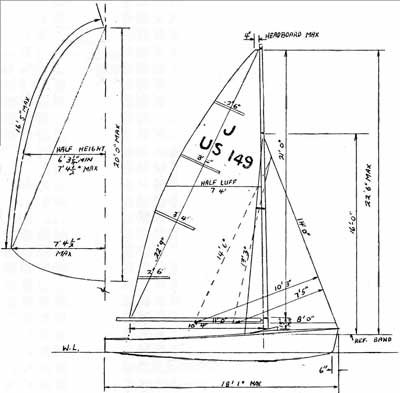
Sir Richard was an avid sailing enthusiast having been a part owner with Sir T.O.M Sopwith in the ownership of the J Class yacht Shamrock V during the 1930s. So it was natural that he should turn his attention to boat building to utilize some of the surplus production capacity in his aircraft factories after the War. What distinguished the Fairey dinghies was the method of construction earlier developed for the Fairey aircraft: a hot molding process joining multiple layers of thin wood veneers and glue to produce an extremely light and extremely strong hull.
Uffa Fox designed the Jollyboat to the following specifications:
- Overall Length 18 feet
- Waterline Length 17 feet 6 inches
- Beam 5 feet
- Draft ( board down) 4 feet 9 inches
- Sail Area 160 square feet
- Hull Weight 250 pounds minimum
Note the last spec...250 pounds...an amazing weight for such a large dinghy of its time. The weight included partial decks forward and aft, molded port and starboard wooden flotation tanks, and a relatively high freeboard. This was truly the high-tech dinghy of its day and a beauty to behold when maintained with its original varnished finish.
And, man, was it fast! An extract from Uffa Foxs 1950s book, Inshore Dinghy Sailing, states:
No single hull dinghy has ever exceeded the timed speed of the Jollyboat over a measured distance. Sailed by Charles Curry in 1954 off Cowes in a Force 5 wind, the Jollyboat covered five cables at a speed of 13.4 knots. The sea was one in which the heights of the waves were between 4 ft and 5 ft, and it was not surprising that Ralph Vines later in the same year put up an average over three runs of 17.8 knots in the smoother waters of Edgebastor Reservoir. Times trials over a distance have now gone out of fashion and it is certain that more recent and improved versions of the Jollyboat have gone faster since 1954.
Stories of the Jollyboats speed were notorious for their supposed exaggeration. Some would even claim that a Jolly could pull a water-skier in the right conditions. Your author was a skeptic until he had actually seen a photograph of a Jollyboat performing this feat. And there is little doubt that, after the trapeze was adopted in 1959, the 20 knot barrier was regularly exceeded.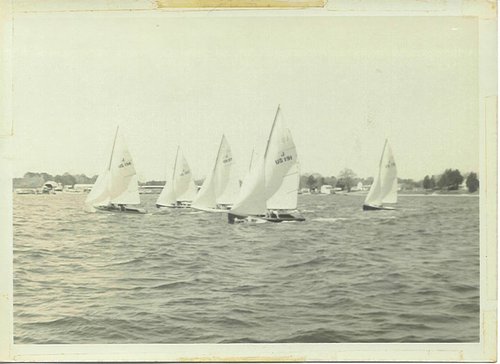
The Jollyboat at FBYC
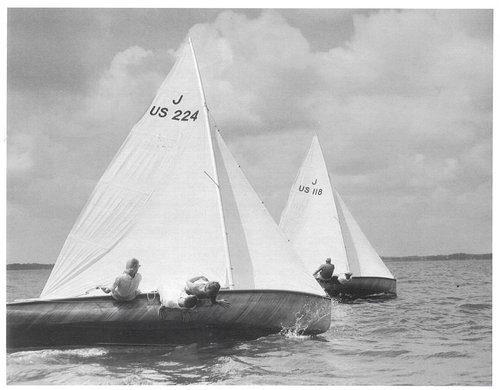 |
| Jollyboats Racing in 1959 at FBYC |
Coincidentally, on August 19, 1956, the Jollyboat and the Mobjack made their first racing appearances at the FBYC Annual Regatta. Both represented a new genre of racing dinghies that quickly spelled doom for the older breeds of boats at FBYC, such as the Hampton One Design. Both the Jolly and the Mobjack were lighter craft built of modern materials adapted to mass production techniques, the Mobjack fiberglass and the Jolly molded plywood, and both were designed with planing hulls. Sailors were eager to notch up performance on the racecourse. FBYC Hampton One class champions, Lloyd Emory and George Roper, immediately purchased Jollyboats as well as Club stalwarts Allen McCullogh, Dr. Eddy Eppes, Dr. Howard McCue, Pat Gibson, Murray Clark, and Ralph Lynn.
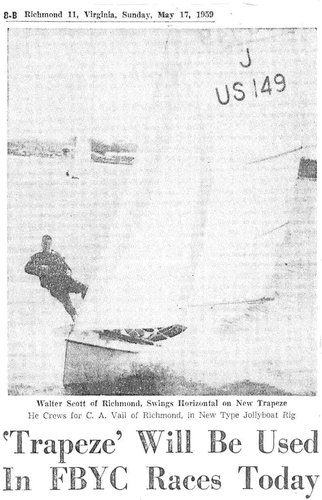 Further south on the Bay, fleets mushroomed at yacht clubs in Hampton, Norfolk, and Langley Field while nationwide fleets formed at Long Island, Marblehead, Sandusky, Augusta, and Charlotte. Internationally, there were fleets in Great Britain, Canada, Australia, and New Zealand. By 1959, the United States, England, and Canada with Australia and New Zealand joining soon thereafter had established an International Jollyboat Association. The first International Championship was scheduled for the following year in 1960, and, in September 1959, the first North American Championship was held at the Westhampton Yacht Club on Long Island, attracting 38 starters. FBYCs Lloyd Emory was 5th in this event, and clubmember Ralph Lynn was elected President of the North American Jollyboat Association at the Annual Meeting. The Jollyboat had truly experienced instant acceptance and meteoric growth.
Further south on the Bay, fleets mushroomed at yacht clubs in Hampton, Norfolk, and Langley Field while nationwide fleets formed at Long Island, Marblehead, Sandusky, Augusta, and Charlotte. Internationally, there were fleets in Great Britain, Canada, Australia, and New Zealand. By 1959, the United States, England, and Canada with Australia and New Zealand joining soon thereafter had established an International Jollyboat Association. The first International Championship was scheduled for the following year in 1960, and, in September 1959, the first North American Championship was held at the Westhampton Yacht Club on Long Island, attracting 38 starters. FBYCs Lloyd Emory was 5th in this event, and clubmember Ralph Lynn was elected President of the North American Jollyboat Association at the Annual Meeting. The Jollyboat had truly experienced instant acceptance and meteoric growth.
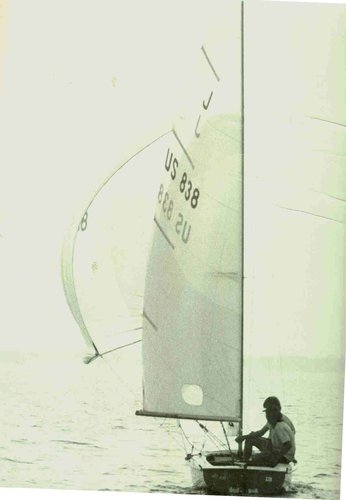 |
| Lud Kimbrough & Brent Halsey, Jr. in a glass Jolly circa 1971) |
During the first decade of their existence (1956-65), fleets on the Bay prospered and sailing was intensely competitive. A partial list of the standout skippers during this period is included here for the historical record: Lloyd Emory (FBYC), George Roper (FBYC), Ralph Lynn (FBYC), R.A.F. Cdr.Bunny Smith (LYC), Dinky Vail (NYCC), Dr. Lloyd Griffin (Elizabeth City), Beans Weatherly (Pasquotank River Sailing Association), Happy Hogshire (NYCC), Ray Munsch (FBYC), Johnny Hawksworth (FBYC), and Jack Moseley (FBYC). (The last skipper listed was ably assisted by the author as crew and part owner of J189, irreverently named Bite I.)
So what happened to the Jollyboat? After its first decade of explosive growth, the Bay fleet began to stall and then falter with the influx of the 505 and the Flying Dutchman, the latter gaining appeal from its acceptance as an Olympic class. (These upstarts may have had the edge in speed to windward but neither equaled the Jollys blazing speed on a reach.) And the Jollyboat was a wooden boat that suffered from its late transition to construction in low maintenance fiberglass that was fast becoming the choice for mass-produced hulls. The first fiberglass editions of the Jolly did not appear until the mid-1960s but could never match the rigidity to weight ratio of the molded ply version. Before the old Columbia Yachts Corporation in Portsmouth, Virginia went belly up in the 1970s, Ralph Lynn convinced the company to build and market a fiberglass Jolly, but this effort fizzled. By the late 1970s, the Jollyboat had all but vanished from the racing scene. The 1959 sailing season represented a milestone in the history of the Jollyboat when trapezes were legalized for racing. This eliminated the third crewmember required to race competitively and began a trend toward younger crews because of the acrobatics required to keep the boat on its feet. This youth movement happen to coincide with War babies, like the author and his friends, entering their late teens. But there were other aspects of the sport that made us whippersnappers gravitate toward the Jollyboat besides scintillating speed and the top gun competition. We were really impressed with the ability of those Jollyboaters to party! One can recall nostalgically some of the fleet elders actually swinging from the rafters in the old clubhouse jubilantly celebrating a day of racing, and we looked in awe at their prodigious consumption of Gloucester Cokes, lethal concoctions of rum and cola. And not many of us will forget the image of ace sailor Dinky Vail from Norfolk hauling his Jollyboat to regattas behind a convertible Cadillac containing at least two blonde babes, hair flowing in the wind. These guys knew how to have fun, and we wanted part of the action.
Ralph C. Lynn, Godfather of the Jollyboat Fleet
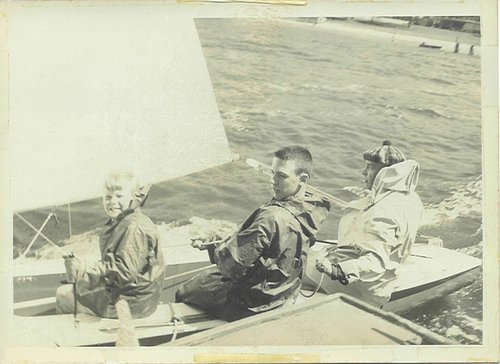 |
| (L-R) Drew Sinnickson and Johnny Hawksworth with Ralph Lynn frostbiting in 1958 |
Ralph C. Lynn was, by most measures, the dominant personality at FBYC during the 1950s, 60s, and 70s. From the formation of the Jollyboat fleet at our club in 1956, he became its tireless promoter, caretaker, and ambassador who nurtured the class from its exuberant beginnings through its demise as a viable racing fleet in the 1970s.
I know little about Ralphs youth except that he grew up sailing on Long Island Sound. He went to college at Washington and Lee University in Lexington where he distinguished himself on the varsity boxing team. Since his college years coincided with the era of Prohibition, he often regaled us youngsters with stories of evading the revenuers in order to secure moonshine for fraternity parties. After law school, he eventually set up a small legal practice in Richmond to support his sailing avocation. While the date that he joined the Club is not known, the 1952 FBYC Yearbook shows that he was a member in that year with a 42-foot motor yacht named Wailani but no sailboats were then registered in his name.
He and his lovely (and very understanding) wife, Marie, lived on Hawthorne Avenue in the northside of Richmond. After founding the Jollyboat fleet, he constructed a huge workshop behind his home capable of servicing under roof all the needs of the Jolly and its rigging. And Ralph encouraged all fleetmembers to use this facility. During the winter, he scheduled once a month racing rules seminars where we all gathered around him to analyze and discuss the Appeal Decisions of the North American Yacht Racing Union. Many older clubmembers will recall the famous spaghetti dinners at the old clubhouse where Ralph and Marie would serve up meals to raise money for the Jollyboat fleet.
In the spring of 1960, Ralph incorporated the Chesapeake Jollyboat Sales and Service Company staffed with officers who were all members of FBYC. That summer he attended the first Jollyboat Worlds Championship hosted by the Royal Thames Yacht Club on the Solent. He finished 6th in a heavy air series characterized by numerous capsizes and returned home with a Royal Thames burgee that still hangs upstairs in our new Clubhouse. Later in the decade he sailed at St. Aubin, in St. Aubin's Bay in the English Channel to compete in the 1964 Jollyboat Worlds where he won the Overseas Trophy and finished 11th overall.
Seriously overweight, Ralph sailed hard and partied even harder. He was usually seen about the Club grounds with his belligerent boxer restrained by a metal halter that, nevertheless, did not prevent the canine from engaging in vicious fights with other dogs on Sunday afternoons after the races. This behavior was responsible for the No Dogs Allowed rule that the Club promulgated for nearly 40 years. As the years thundered by, Ralph still continued to race but somewhat less competitively. His crew preference changed from agile young men to attractive young women. And he became increasingly content to promote the fleet traveling around the country to various sailing venues and to engage in social activities ashore, during which he practiced his extraordinary skill as a raconteur. After several strokes and practically deaf without hearing aids, Ralph encouraged the author to crew in his last Jollyboat North American Championship at Fishing Bay in the early 1970s. Delicately balanced above the waves in my trapeze, Ralph, chain-smoking and downing a pre-race brew, informed me in his British-styled accent that he had no feeling in his arm grasping the tiller but that I should not be alarmed. (Yikes!) Somehow we managed to finish the series without a medical emergency.
Ralph wisely retired from racing soon thereafter but continued to serve the Club as Chairman of the Race Committee for several years before his death. While he never served as Commodore, he must be considered as one of FBYCs most influential sailing ambassadors.
The Jollyboat Today
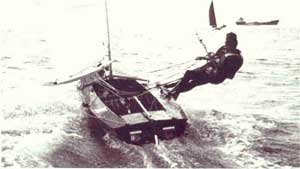 |
| a "Souped Up" Vintage Jollyboat |
Remarkably the Jollyboat survives in England where a classic boat owners association races restored antique dinghies. Some of these ancient Jollys have even been souped up with taller masts, larger sailplans, efficient blades, and double trapezes. No telling what the speed record is now. And in Australia, there is still one remaining active fleet of about twenty Jollys that compete regularly but without trapeze necessitating a crew of three. Sadly, no new editions are being minted so when these relics disintegrate, the Jolly will have gone the way of the dinosaur. A surprising amount of information on the Jollyboat can still be obtained using a search engine on the Internet, and plans are available from the Uffa Fox Design Company in Great Britain.
Did you know?
- Seven past FBYC Commodores campaigned Jollyboats: Patrick Gibson, Alan McCullough, Howard McCue, Hiram Pritchard, Jere Dennison, Johnny Hawksworth, and Happy Hubard.
- The original Jollyboat mast was a composite made of both aluminum and balsawood. Early aluminum masts could not be extruded with a tapered top section. So a tapered balsawood tip was affixed to the top of the aluminum mast above the tangs to allow the rig to flex for a flatter sail in heavy air and to dump wind during gusts.
- In the early days of the Jolly, it was not considered necessary or manly to carry life jackets aboard the boat. Since the hull incorporated positive flotation air tanks and was designed to be self-rescuing, the theory was that you could avoid drowning by just hanging on the hull if you were unable to sail the water out of her after a capsize.
- The original Jollyboat incorporated a small screw jack under the base of the mast that one had only to crank up or down to retension the rig. This operation could easily be performed while underway, even while racing